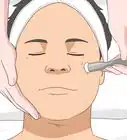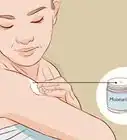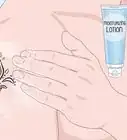This article was co-authored by Margareth Pierre-Louis, MD. Dr. Margareth Pierre-Louis is a board certified Dermatologist and Dermatopathologist, Physician Entrepreneur, and the Founder of Twin Cities Dermatology Center and Equation Skin Care in Minneapolis, Minnesota. Twin Cities Dermatology Center is a comprehensive dermatology clinic treating patients of all ages through clinical dermatology, cosmetic dermatology, and telemedicine. Equation Skin Care was created to provide the best in evidence-based, natural skin care products. Dr. Pierre-Louis earned a BS in Biology and an MBA from Duke University, an MD from the University of North Carolina at Chapel Hill, completed a residency in dermatology at the University of Minnesota, and completed a dermatopathology fellowship at Washington University in St Louis. Dr. Pierre-Louis is board certified in dermatology, cutaneous surgery, and dermatopathology by the American Boards of Dermatology and Pathology.
There are 10 references cited in this article, which can be found at the bottom of the page.
This article has been viewed 178,238 times.
A blemish is a small mark, flaw, or imperfection, typically on your face. Sometimes they appear out of nowhere and at the worst time. When you have blemishes on your face, it is easy to be self-conscious about them. Luckily, you don’t have to let them ruin your day. You can cover them up by lessening the inflammation and layering your makeup properly.
Steps
Lessening the Inflammation
-
1Clean with a cleanser containing either glycolic acid or sulfur. Inflammation of a blemish is usually caused by picking. If this is the case, make sure you clean the blemish before placing makeup on or around it. These two chemical cleansers will help heal your blemish in just a few days and won’t be noticeable beneath makeup.[1]
-
2Use Visine or ice. Before you apply any makeup, you should reduce the swelling as much as you can. Use Visine or ice to reduce the swelling and flatten the blemish. This will help make up go on smoother and hide the blemish more effectively.[2]
- A drop of Visine directly on the blemish is all you need.
- Hold ice on the blemish for 3-5 minutes to reduce swelling.
Advertisement -
3Use a tinted moisturizer. Before applying any makeup, apply a tinted moisturizer. This will help even out your skin tone. Use this instead of a full-coverage foundation because the moisturizer will be much lighter and less likely to cause more blemishes.[3]
Using Layers
-
1Use a yellow colored concealer. If you have a red blemish on your face, you want to use proper makeup to tone down the redness. A yellow color corrector is the most efficient at diminishing redness.[4]
- Use a makeup sponge to apply your concealer because using your finger transfers oils.
-
2Choose a natural foundation. After you’ve used your corrector on the blemish, you want to find a foundation that is the exact shade of your skin tone. You want it to look as natural as possible.
- The idea that a dark concealer will hide your blemish better is just a myth.[5]
-
3Finish with a powder. Use a dusting powder to offset any remaining oil. The powder should match your skin tone and you should stick to one layer of powder. Putting on extra layers of powder will cause you to look cakey.[6]
-
4Bring your concealer with you. When you have blemishes that you’ve covered before you left the house, you should bring concealer with you when you leave. Especially if you have oily skin, you will need it for touch ups. Concealer is prone to fading on oily skin. To keep the blemishes hidden all day long, spot touch up with your concealer.[7]
Hiding More Prominent Blemishes
-
1Highlight around the blemish. This may sound counteractive, but if the blemish is large enough that it casts a shadow, you should counteract it by creating an optical illusion. Do this by using a highlighting concealer under the blemish. Your next layers of makeup will continue to reduce the visibility of the blemish while allowing the light to bounce off of the highlighter. This illusion will take away from the severity of depth in your blemish.
-
2Use a masking cosmetic. A masking cosmetic is makeup that is thicker than concealer. It has added pigment as well. If you’re trying to hide scars or other prominent blemishes, use a masking cosmetic as your concealer.[8]
-
3Use a finishing spray. When covering more prominent blemishes, a finishing spray is great. It will help keep your blemish concealed. Your finishing spray should go on directly after you finish covering your blemish. Apply your eye makeup and lip color after your spray.[9]
- If you have smaller blemishes, a finishing spray is not necessary, but you may choose to use one.
Expert Q&A
-
QuestionHow can I prevent whiteheads?
 Margareth Pierre-Louis, MDDr. Margareth Pierre-Louis is a board certified Dermatologist and Dermatopathologist, Physician Entrepreneur, and the Founder of Twin Cities Dermatology Center and Equation Skin Care in Minneapolis, Minnesota. Twin Cities Dermatology Center is a comprehensive dermatology clinic treating patients of all ages through clinical dermatology, cosmetic dermatology, and telemedicine. Equation Skin Care was created to provide the best in evidence-based, natural skin care products. Dr. Pierre-Louis earned a BS in Biology and an MBA from Duke University, an MD from the University of North Carolina at Chapel Hill, completed a residency in dermatology at the University of Minnesota, and completed a dermatopathology fellowship at Washington University in St Louis. Dr. Pierre-Louis is board certified in dermatology, cutaneous surgery, and dermatopathology by the American Boards of Dermatology and Pathology.
Margareth Pierre-Louis, MDDr. Margareth Pierre-Louis is a board certified Dermatologist and Dermatopathologist, Physician Entrepreneur, and the Founder of Twin Cities Dermatology Center and Equation Skin Care in Minneapolis, Minnesota. Twin Cities Dermatology Center is a comprehensive dermatology clinic treating patients of all ages through clinical dermatology, cosmetic dermatology, and telemedicine. Equation Skin Care was created to provide the best in evidence-based, natural skin care products. Dr. Pierre-Louis earned a BS in Biology and an MBA from Duke University, an MD from the University of North Carolina at Chapel Hill, completed a residency in dermatology at the University of Minnesota, and completed a dermatopathology fellowship at Washington University in St Louis. Dr. Pierre-Louis is board certified in dermatology, cutaneous surgery, and dermatopathology by the American Boards of Dermatology and Pathology.
Board Certified Dermatologist Try using a chemical exfoliant, like retinoic acid, to help prevent whiteheads. Chemical exfoliants can be purchased over the counter and used once a week.
Try using a chemical exfoliant, like retinoic acid, to help prevent whiteheads. Chemical exfoliants can be purchased over the counter and used once a week.
References
- ↑ http://www.minq.com/beauty/1536/13-pro-makeup-tips-to-conceal-blemishes#page=2
- ↑ http://www.minq.com/beauty/1536/13-pro-makeup-tips-to-conceal-blemishes#page=3
- ↑ http://www.minq.com/beauty/1536/13-pro-makeup-tips-to-conceal-blemishes#page=5
- ↑ http://makeup.allwomenstalk.com/must-try-makeup-tricks-to-cover-blemishes/2/
- ↑ http://www.minq.com/beauty/1536/13-pro-makeup-tips-to-conceal-blemishes#page=5
- ↑ http://makeup.allwomenstalk.com/must-try-makeup-tricks-to-cover-blemishes/9/
- ↑ http://www.minq.com/beauty/1536/13-pro-makeup-tips-to-conceal-blemishes#page=4
- ↑ http://makeup.allwomenstalk.com/must-try-makeup-tricks-to-cover-blemishes/4/
- ↑ http://www.goodhousekeeping.com/beauty/makeup/a32862/cover-acne-scars-with-makeup/
- ↑ Margareth Pierre-Louis, MD. Board Certified Dermatologist. Expert Interview. 15 May 2020.
- Videos provided by Sierra Furtado
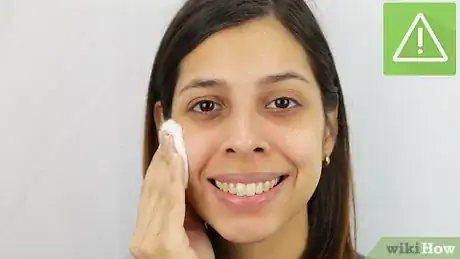

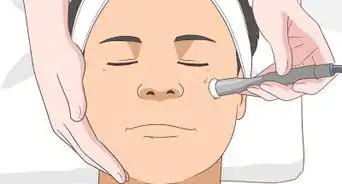







-Step-12-Version-3.webp)






